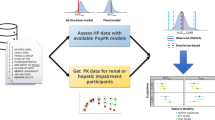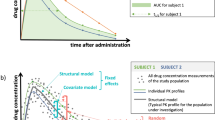Abstract
Background and objective
Rurioctacog alfa pegol (Adynovate) is a modified recombinant factor VIII concentrate used for treating hemophilia A. Aiming to improve treatment tailoring on the Web-Accessible Population Pharmacokinetic Service-Hemophilia (WAPPS-Hemo) platform for patients of all ages treated with Adynovate, we have developed and evaluated a population pharmacokinetic (PopPK) model. On the platform, PopPK models are used as priors for Bayesian forecasting that derive individual PK of hemophilia patients and are subsequently used for personalized dose regimen design.
Methods
Factor activity measurements and demographic covariate data from patients infused with Adynovate were extracted from the WAPPS-Hemo database. Evaluations testing the appropriateness of Bayesian forecasting included 10-fold cross validation, a limited sampling analysis (LSA), and an external evaluation using additional independent data extracted from the WAPPS-Hemo database at a later date.
Results
The model was constructed using 650 plasma factor activity observations (555 one stage assay and 95 chromogenic assay – 4.6% below limit of quantification) measured in 154 patients from 36 hemophilia centres. A two-compartment model including between subject variability on clearance and central volume was selected as the base model. Covariates were fat free mass on clearance and central volume, age on clearance and assay type on activity. The final model was well-suited to predict PK parameters of new individuals (n = 26) from sparse observations.
Conclusions
The development of a PopPK model for Adynovate using real-world data increases the covariate space (e.g. age) beyond what is possible from clinical trial data. This model is available on the WAPPS-Hemo platform for tailoring treatment in hemophilia A patients.




Similar content being viewed by others
References
Davie E. Biochemical and molecular aspects of the coagulation cascade. Thromb Haemost. 1995;74:1–6. https://doi.org/10.1056/NEJM200106073442307.
Stonebraker JS, Bolton-Maggs PH, Soucie JM, Walkers I, Brooker M. A study of variations in the reported haemophilia A prevalence around the world. Haemophilia. 2010;16:20–32. https://doi.org/10.1111/j.1365-2516.2009.02127.x.
Iorio A, Marchesini E, Marcucci M, Stobart K, Chan AK. Clotting factor concentrates given to prevent bleeding and bleeding-related complications in people with hemophilia A or B. Cochrane Database Syst Rev. 2011;9:CD003429. https://doi.org/10.1002/14651858.cd003429.pub4.
Nilsson I, Berntorp E, Löfqvist T, Pettersson H. Twenty-five years’ experience of prophylactic treatment in severe haemophilia A and B. J Intern Med. 1992;232:25–32.
McEneny-King A, Iorio A, Foster G, Edginton AN. The use of pharmacokinetics in dose individualization of factor VIII in the treatment of hemophilia A. Expert Opin Drug Metab Toxicol. 2016;19:1–9. https://doi.org/10.1080/17425255.2016.1214711.
Collins PW. Personalized prophylaxis. Haemophilia. 2012;18:131–5. https://doi.org/10.1111/j.1365-2516.2012.02838.x.
Petrini P, Valentino LA, Gringeri A, Re WM, Ewenstein B. Individualizing prophylaxis in hemophilia: a review. Expert Rev Hematol. 2015;8:237–46. https://doi.org/10.1586/17474086.2015.1002465.
Iorio A, Blanchette V, Blatny J, Collins P, Fischer K, Neufeld E. Estimating and interpreting the pharmacokinetic profiles of individual patients with hemophilia A or B using a population pharmacokinetic approach: communication from the SSC of the ISTH. J Thromb Haemost. 2017;15:2461–5. https://doi.org/10.1111/jth.13867.
Iorio A, Keepanasseril A, Foster G, Navarro-Ruan T, McEneny-King A, Edginton AN, et al. Development of a Web-Accessible Population Pharmacokinetic Service-Hemophilia (WAPPS-Hemo): study protocol. JMIR Res Protoc. 2016;5:e239. https://doi.org/10.2196/resprot.6558.
Ette EI, Williams PJ. Population pharmacokinetics I: background, concepts, and models. Ann Pharmacother. 2004;38:1702–6. https://doi.org/10.1345/aph.1D374.
Holford NH, Buclin T. Safe and effective variability—a criterion for dose individualization. Ther Drug Monit. 2012;34:565–8. https://doi.org/10.1097/FTD.0b013e31826aabc3.
Hamberg A-K, Hellman J, Dahlberg J, Jonsson EN, Wadelius M. A Bayesian decision support tool for efficient dose individualization of warfarin in adults and children. BMC Med Inform Decis Mak. 2015;15:7. https://doi.org/10.1186/s12911-014-0128-0.
Brekkan A, Berntorp E, Jensen K, Nielsen E, Jonsson S. Population pharmacokinetics of plasma-derived factor IX: procedures for dose individualization. J Thromb Haemost. 2016;14:724–32.
Bolon-Larger M, Chamouard V, Bressolle F, Boulieu R. A limited sampling strategy for estimating individual pharmacokinetic parameters of coagulation factor VIII in patients with hemophilia A. Ther Drug Monit. 2007;29:20–6.
Bjorkman S. Limited blood sampling for pharmacokinetic dose tailoring of FVIII in the prophylactic treatment of haemophilia A. Haemophilia. 2010;16:597–605. https://doi.org/10.1111/j.1365-2516.2009.02191.x.
Preijers T, Hazendonk H, Fijnvandraat K, Leebeek F, Cnossen M, Mathôt R. In silico evaluation of limited blood sampling strategies for individualized recombinant factor IX prophylaxis in hemophilia B patients. J Thromb Haemost. 2017;15:1737–46. https://doi.org/10.1111/jth.13771.
Stemberger M, Kallenbach F, Schmit E, McEneny-King A, Germini F, Yeung C, et al. Adopting population pharmacokinetics for tailoring prophylaxis in haemophilia A patients: a historically controlled observational study. Thromb Haemost. 2019;119:368–76. https://doi.org/10.1055/s-0039-1677700.
Nagao A, Yeung C, Germini F, Suzuki T. Clinical outcomes in hemophilia A patients undergoing tailoring of prophylaxis based on population-based pharmacokinetic dosing. Thromb Res. 2019;173:79–84. https://doi.org/10.1016/j.thromres.2018.11.017.
Turecek PL, Bossard MJ, Graninger M, Gritsch H, Höllriegl W, Kaliwoda M, et al. BAX 855, a PEGylated rFVIII product with prolonged half-life. Development, functional and structural characterisation. Hamostaseologie. 2012;32:S29–38.
Stidl R, Fuchs S, Bossard M, Siekmann J, Turecek PL, Putz M. Safety of PEGylated recombinant human full-length coagulation factor VIII (BAX 855) in the overall context of PEG and PEG conjugates. Haemophilia. 2016;22:54–64. https://doi.org/10.1111/hae.12762.
Konkle BA, Stasyshyn O, Chowdary P, Bevan DH, Mant T, Shima M, et al. Pegylated, full-length, recombinant factor VIII for prophylactic and on-demand treatment of severe hemophilia A. Blood. 2015;126:1078–85. https://doi.org/10.1182/blood-2015-03-630897.
Brand B, Gruppo R, Wynn TT, Griskevicius L, Lopez Fernandez MF, Chapman M, et al. Efficacy and safety of pegylated full-length recombinant factor VIII with extended half-life for perioperative haemostasis in haemophilia A patients. Haemophilia. 2016;22:e251–8. https://doi.org/10.1111/hae.12963.
Nestorov I, Neelakantan S, Ludden TM, Li S, Jiang H, Rogge M. Population pharmacokinetics of recombinant factor VIII Fc fusion protein. Clin Pharmacol Drug Dev. 2015;4:163–74. https://doi.org/10.1002/cpdd.167.
Zhang Y, Roberts J, Veldman A, St Ledger K, Feussner A, Sidhu J. Population pharmacokinetics of recombinant coagulation factor VIII-SingleChain in patients with severe hemophilia A. J Thromb Haemost. 2017;15:1106–14.
Garmann D, McLeay S, Shah A, Vis P, Maas Enriquez M, Ploeger B. Population pharmacokinetic characterization of BAY 81-8973, a full-length recombinant factor VIII: lessons learned; importance of including samples with factor VIII levels below the quantitation limit. Haemophilia. 2017;23:528–37.
Chelle P, Yeung C, Bonanad S, Muñoz J, Ozelo M, Megías-Vericat J, et al. Routine clinical care data for population pharmacokinetic modeling: the case for Fanhdi/Alphanate in hemophilia A patients. J Pharmacokinet Pharmacodyn. 2019. https://doi.org/10.1007/s10928-019-09647-2(Epub ahead of print).
McEneny-King A, Chelle P, Foster G, Keepanasseril A, Iorio A, Edginton A. Development and evaluation of a generic population pharmacokinetic model for standard half-life factor VIII for use in dose individualization. J Pharmacokinet Pharmacodyn. 2019. https://doi.org/10.1007/s10928-019-09634-7(Epub ahead of print).
Beal SL. Ways to fit a PK model with some data below the quantification limit. J Pharmacokinet Pharmacodyn. 2001;28(5):481–504. https://doi.org/10.1023/A:1012299115260.
Bergstrand M, Karlsson MO. Handling data below the limit of quantification in mixed effect models. AAPS J. 2009;11(2):371–80. https://doi.org/10.1208/s12248-009-9112-5.
Al-Sallami HS, Goulding A, Grant A, Taylor R, Holford N, Duffull SB. Prediction of fat-free mass in children. Clin Pharmacokinet. 2015;54(11):1169–78.
Karlsson M, Savic R. Diagnosing model diagnostics. Clin Pharmacol Ther. 2007;82:17–20.
Bergstrand M, Hooker AC, Wallin JE, Karlsson MO. Prediction-corrected visual predictive checks for diagnosing nonlinear mixed-effects models. AAPS J. 2011;13:143–51. https://doi.org/10.1208/s12248-011-9255-z.
Iorio A, Edginton A, Blanchette V, Blatny J, Boban A, Cnossen M, et al. Performing and interpreting individual pharmacokinetic profiles in patients with hemophilia A or B: rationale and general considerations. Res Pract Thromb Haemost. 2018;2:1–14. https://doi.org/10.1002/rth2.12106.
Lalezari S, Martinowitz U, Windyga J, Enriquez MM, Delesen H, Schwartz L, et al. Correlation between endogenous VWF: Ag and PK parameters and bleeding frequency in severe haemophilia A subjects during three-times-weekly prophylaxis with rFVIII-FS. Haemophilia. 2014;20:e15–22. https://doi.org/10.1111/hae.12294.
Acknowledgements
The authors gratefully acknowledge the following centers that contributed to this study by providing their data on the WAPPS-Hemo platform: Boston Children’s Hospital, Boston, MA, USA; St. Michael’s Hospital, Toronto, ON, Canada; SickKids Hospital, Toronto, ON, Canada; Center for Bleeding and Clotting, Minneapolis, MN, USA; Gulf States Hemophilia and Thrombophilia Center, Houston, TX, USA; St. Jude Children’s Research Hospital, Memphis, TN, USA; Hospital University and Politechnic La Fe, Valancia, Spain; Valley Children’s Healthcare, Madera, CA, USA; Center for Inherited Blood Disorders, Orange, NJ, USA; Rady Children’s Hospital, San Diego, CA, USA; Universitätsklinikum Bonn, Bonn, Germany; Department of Hematology and Central Hematology Laboratory, Inselspital, Bern University Hospital, University of Bern, Bern, Switzerland; Ogikubo Hospital, Tokyo, Japan; Royal Adelaide Hospital, Adelaide, SA, Australia; St. Jude Affiliate Clinic at Novant Health Hemby Children’s Hospital, Charlotte, NC, USA; The Women’s and Children’s Hospital, Adelaide, SA, Australia; University of Florida, Gainesville, FL, USA; Zurich University Hospital, Zurich, Switzerland; University of Miami Hemophilia Treatment Center, Miami, FL, USA; Bloodworks Northwest, Seattle, WA, USA; Kyung Hee University Hospital at Gangdong, Seoul, Republic of Korea; Universitaets-Kinderklinik Wien, Vienna, Austria; The Maine Hemophilia and Thrombosis Center, Scarborough, ME, USA; Ronald Sawers Haemophilia Treatment Centre, Melbourne, VIC, Australia; St. Paul’s Hospital, Vancouver, BC, Canada; University Children’s Hospital, Hemophilia Center, Berne, Switzerland; University of Iowa Children’s Hospital, Iowa City, IA, USA; Children’s Minnesota, Minneapolis, MN, USA; Children’s Hospital of Michigan, Detroit, MI, USA; Integral Solutions SD S.A.S, Bogota, Columbia; Northwest Ohio Hemophilia Treatment Center, Toldeo, OH, USA.
Author information
Authors and Affiliations
Corresponding author
Ethics declarations
Funding
No sources of funding were received for the preparation of this article or conduct of this study.
Conflict of Interest
PC, CHTY, JL, CA, YSP, TW, HT and AI declared they had no conflict of interest or that their conflict of interest was not relevant to this publication. SEC has served as a consultant for Shire. VB served on the Speakers bureau for Shire. SB has received grants from Baxalta and Takeda for studies about PK-tailored therapy in patients with severe hemophilia A using a specific tool (myPKFiT), has lectured and has been part of medical and commercial advisory boards organized by Takeda and Baxalta in the past, and has chaired meetings about rurioctocog. JEMV has received research support from Shire and Grifols and speaker, support consulting fees from Bayer, CSL Behring, Grifols, NovoNordisk, Pfizer, Shire, Sobi, Takeda. AN received honoraria from Shire/Baxalta, Bioverative, Bayer and Chugai. FCM served on Octapharma, Shire, Kendrion, Genentech advisory boards. AS served on Shire, Biogen and CSL Behring advisory boards. MC received honoraria from NovoNordisk, Shire, Genentech, Baxalta, Bayer, BPL, Octapharma. ANE has received speaking fees from Bayer.
Electronic supplementary material
Below is the link to the electronic supplementary material.
Rights and permissions
About this article
Cite this article
Chelle, P., Yeung, C.H.T., Croteau, S.E. et al. Development and Validation of a Population-Pharmacokinetic Model for Rurioctacog Alfa Pegol (Adynovate®): A Report on Behalf of the WAPPS-Hemo Investigators Ad Hoc Subgroup. Clin Pharmacokinet 59, 245–256 (2020). https://doi.org/10.1007/s40262-019-00809-6
Published:
Issue Date:
DOI: https://doi.org/10.1007/s40262-019-00809-6




